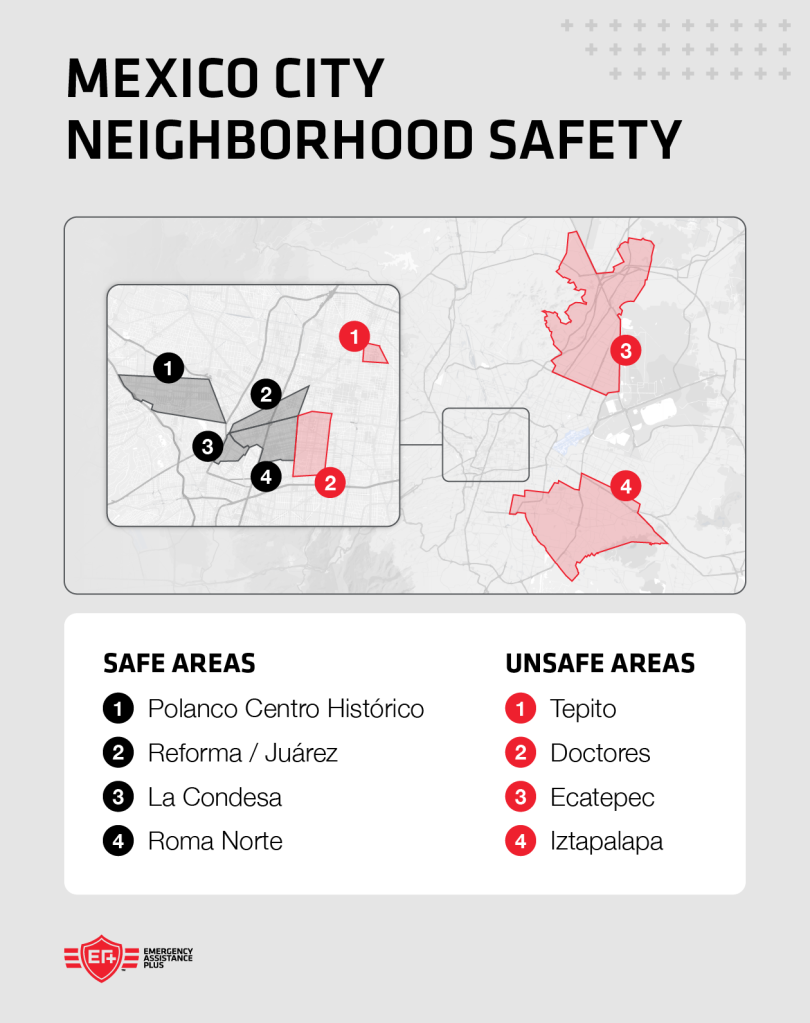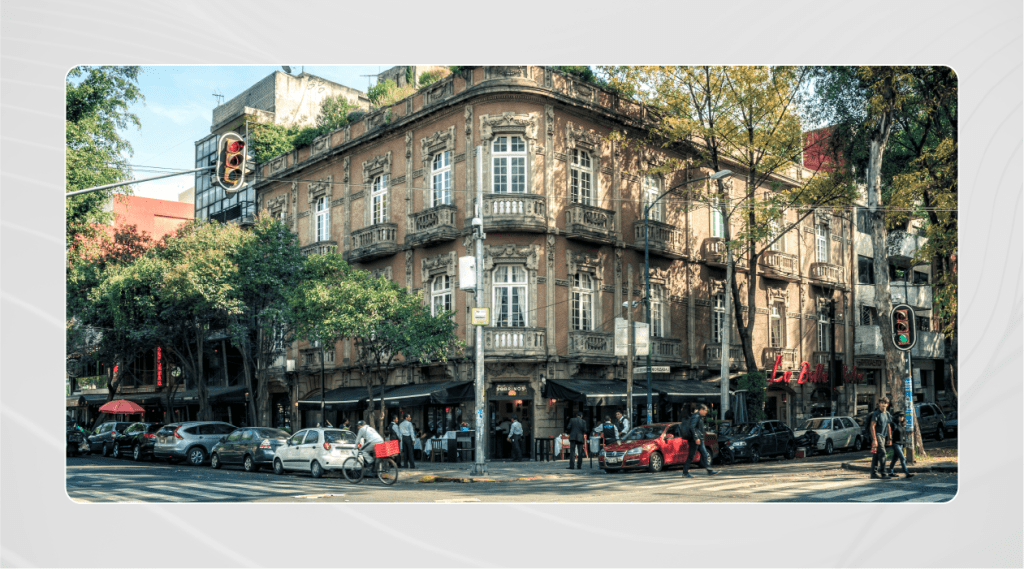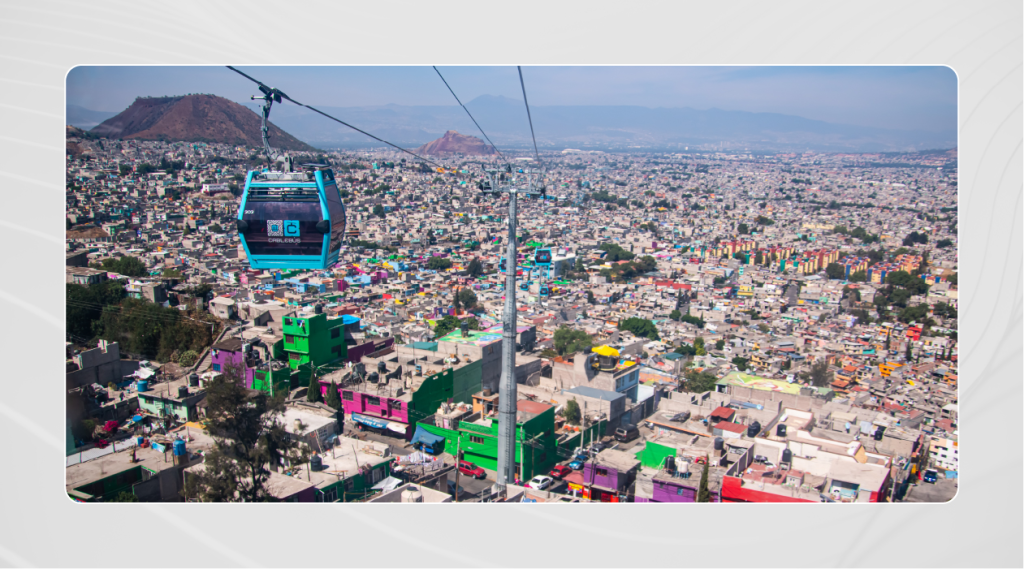Destinations, Travel Tips
Mexico City is generally safe for travelers and is on par with many other popular tourist destinations. Crime levels vary depending on the specific neighborhood and time of day. It’s important to keep an eye on your belongings and exercise caution at night for an issue-free visit.
Mexico’s iconic capital attracts millions of visitors annually, and it’s a world-class destination for snowbirding during the colder months. But is Mexico City safe? The city has a lot to offer, but headlines with cautionary tales make some potential visitors feel uneasy.
With an understanding of the city’s regions and a bit of safety preparedness, you can enjoy a perfectly safe visit on par with other popular vacation spots. For a smooth trip, stick to safer locations and adopt a travel-savvy mindset. This comprehensive guide breaks down where to stay, areas to avoid, and how to prepare yourself for any potential emergency.
Is it safe to travel to Mexico City? According to the U.S. State Department advisory, Mexico City receives an overall Level 2 rating, and encourages visitors to “exercise increased caution.” Travel advisory levels range from 1 to 4, with 1 representing the safest regions. So, relatively speaking, Mexico City is a safer destination.
When travelers take standard precautions, the Mexico City safety rating is comparable to popular travel destinations like the United Kingdom and France. Petty crime is a commonly cited crime, often just outside the patrolled tourist areas.
Mexico City is home to over 22 million people and spans 573 square miles, making it much larger in both population and area than New York City. And like any major metropolis, safety varies widely by neighborhood.

Here are the neighborhoods, locally referred to as colonias, considered safest for travelers:
Condesa blends historical charm with modern flair, and the neighborhood earned the “Barrio Mágico Turístico,” or Magical Tourist Neighborhood, distinction as a must-visit district. Main attractions include Parque México’s lush landscaping and rows of colorful restaurants and shops along Avenida Ámsterdam.
Many consider Condesa one of the safest neighborhoods in the city. Streets are well-lit, most areas are regularly patrolled, and typical crowds consist of expats, locals, and young professionals. It’s a safe and exciting choice for families, solo travelers, and those visiting Mexico City for the first time.

Roma Norte is a vibrant artistic sector in Mexico City, filled with plazas, expertly restored mansions, and street art at every turn. It’s known for the Avenida Álvaro Obregón, a walkable strip dotted with gastronomic favorites.
The Avenida and other popular tourist zones are generally safe, with regular patrolling during the day and night. And while the bohemian neighborhood has less of Condesa’s polished charm and a livelier nightlife scene, it’s an overall trustworthy neighborhood.
Polanco Centro Histórico is known as the “Beverly Hills” of Mexico City, with upscale shopping, dining, and lodging options. Visitors also enjoy the Museo Soumaya and Museo Jumex, two collections that firmly set the neighborhood as the city’s cultural hot spot.
International businesses, embassies, and luxury accommodations ensure constant security and easy access to emergency support, making Polanco Centro Histórico an excellent choice for safety-minded travelers.
Like most major cities, there are neighborhoods with higher crime rates that aren’t best suited for tourists, especially at night.

Take caution in the following areas of Mexico City, known for their dangerous reputations:
You can take actionable steps and follow travel safety trends to ensure you’re safe while taking in all that Mexico City has to offer. As a general rule of thumb, pay attention to your surroundings, research each area you plan to visit, and prepare for any foreseeable emergencies.
Here are additional tips for staying safe in Mexico City:
Pickpocketing is an unfortunate risk in Mexico City. It’s most common in tourist-friendly areas, such as crowded public transportation stops, public squares, and busy markets.
Common targets include tourists with headphones in, those distracted by their phones, and anyone with unattended wallets or bags in sight. You can greatly reduce the risk of an incident by using a hidden money belt or a zipped inner pocket or by carrying your bag on the front of your body. Reduce phone theft by keeping it in a secure place until you’re in a private, secured location.
Using reputable rideshare services in Mexico City makes navigation easy while keeping you as safe as possible. Popular apps like Uber, Cabify, and DiDi help visitors avoid inflated fares and track their driver for added security.
Public transportation is widely available and affordable, but pickpocketing may be a problem at crowded stops, so stay aware and secure your belongings. For the safest commute to and from the Benito Juárez International Airport (MEX), book a ride in advance or make sure to prepay for your taxi at an authorized kiosk.
Even in safer neighborhoods like Condesa, Polanco, and Roma Norte, it’s best to walk in a group and choose well-lit streets after hours. Avoid underpasses, empty parks, or poorly marked side streets late at night. And when in doubt, opt for an Uber or DiDi rideshare instead of walking.
Only travel through the city with what you’ll need for the day. Don’t carry extra credit cards, passports, or travel papers—instead, leave them in your hotel room. Keep your bags secured and attended to at all times, and opt for pants and coats with interior and zippered pockets to deter pickpocketing.
Mexico City’s emergency number is 911, and the line will connect you to medical, police, and fire services. Oftentimes, an operator can transfer a caller to an English-speaking responder for a smoother experience.
Make sure to keep your hotel’s phone number and address on hand in case your phone’s battery dies. You can also familiarize yourself with the nearest U.S. Embassy and keep its number on hand for an additional layer of security.
The Centers for Disease Control and Prevention (CDC) recommends that travelers avoid tap water in Mexico City, as it isn’t safe to drink, especially in rural areas. Although the city water is treated, contaminants still enter through outdated and often unsanitary pipelines and storage tanks. This could lead to intestinal infections like traveler’s diarrhea.
Stick to bottled water at all times, and consider skipping ice in beverages, which may contain tap water. A purification straw or water bottle may also be helpful, especially in less touristy areas of the city.
Even cautious travelers can face emergencies like injury or illness, so it’s important to have a travel protection plan in place. Emergency Assistance Plus® (EA+®) is a strong choice for those visiting Mexico City. An annual membership starts at just $229, with options for solo, family, and group travelers.
Travel assistance includes 24/7 medical evacuation, transportation to a home hospital, and support with personal belongings. Members traveling to Mexico City who experience an emergency can call the EA+ hotline, and the agent will arrange any medical or transportation needs on your behalf. It can be a lifeline if you lose personal documents, get sick, or are involved in an accident.
The most important way to mitigate risk in Mexico City is to prepare for the worst-case scenario so you’re ready to respond to anything. Common travel emergencies can affect even the most prepared travelers, which is why travel assistance or protection programs offer peace of mind.
All things considered, is Mexico City safe? By following basic precautions and staying aware of your surroundings, you can expect a smooth, low-risk experience. No matter what neighborhood you stay in or what time of day it is, make sure to secure your belongings and stick to well-patrolled areas.
EA+ is a reliable travel protection solution that has helped over 2 million travelers secure protection for their time abroad. A team of knowledgeable agents can help with language barriers while abroad and help you strategize in moments of need.
Pricing structures are simple, and EA+ offers amenities like travel companion support, hospital-of-choice privileges, and even pet care when you need it most.
Ready to travel to Mexico City safely and confidently? Enroll now so you’re prepared long before an emergency strikes.
Enroll nowYes, Mexico City is generally considered safe for Americans, especially in well-lit and patrolled neighborhoods like Condesa, Roma Norte, and Polanco Centro Histórico.
Many women safely travel in Mexico City, and like all travelers, can avoid unsafe situations by following basic precautions. Be especially careful in the Iztapalapa neighborhood, known for higher rates of violence against women.
If you need medical help due to a sickness or injury while traveling in Mexico City, seek care at a nearby clinic or hospital or dial 911. Request to talk to an English-speaking staff member.
Reliable travel assistance services like EA+ coordinate emergency logistics and can arrange medical transport back to the U.S. so you can seek treatment at a facility near your home.
Yes, Uber is a safe service in Mexico City. Prices are mediated through the app, which reduces the chances of fare fraud. Drivers and passengers are also tracked, adding a layer of security.
No, Mexico is not on the U.S.’s no-travel list and is on par with many other popular tourist regions like France and the U.K. According to the Mexico City travel advisory, most states in the country are a Level 2 risk, which advises visitors to exercise increased caution.
The main red zones in Mexico City are Doctores, Tepito, Ecatepec, and specific areas of Iztapalapa. These Mexico City neighborhoods to avoid have higher crime rates, primarily theft, robbery, and gang activity. A Mexico City safety map can give you a better idea of where these areas are located.
EA+ offers translation services to help you communicate with medical staff, coordinate care, and arrange long-distance medical transportation home if needed. You’ll have support every step of the way, so language barriers don’t prevent you from receiving the help you need.